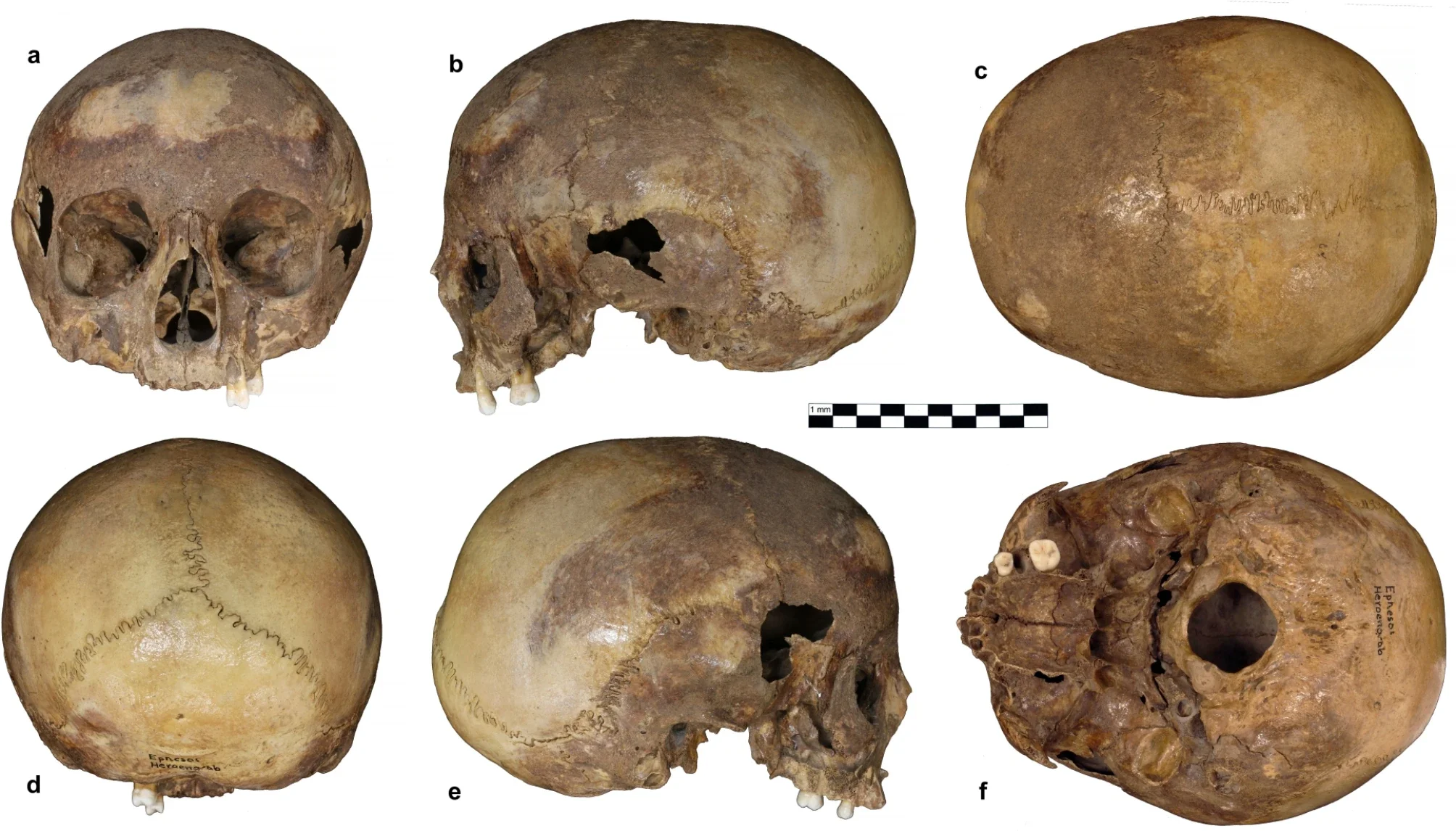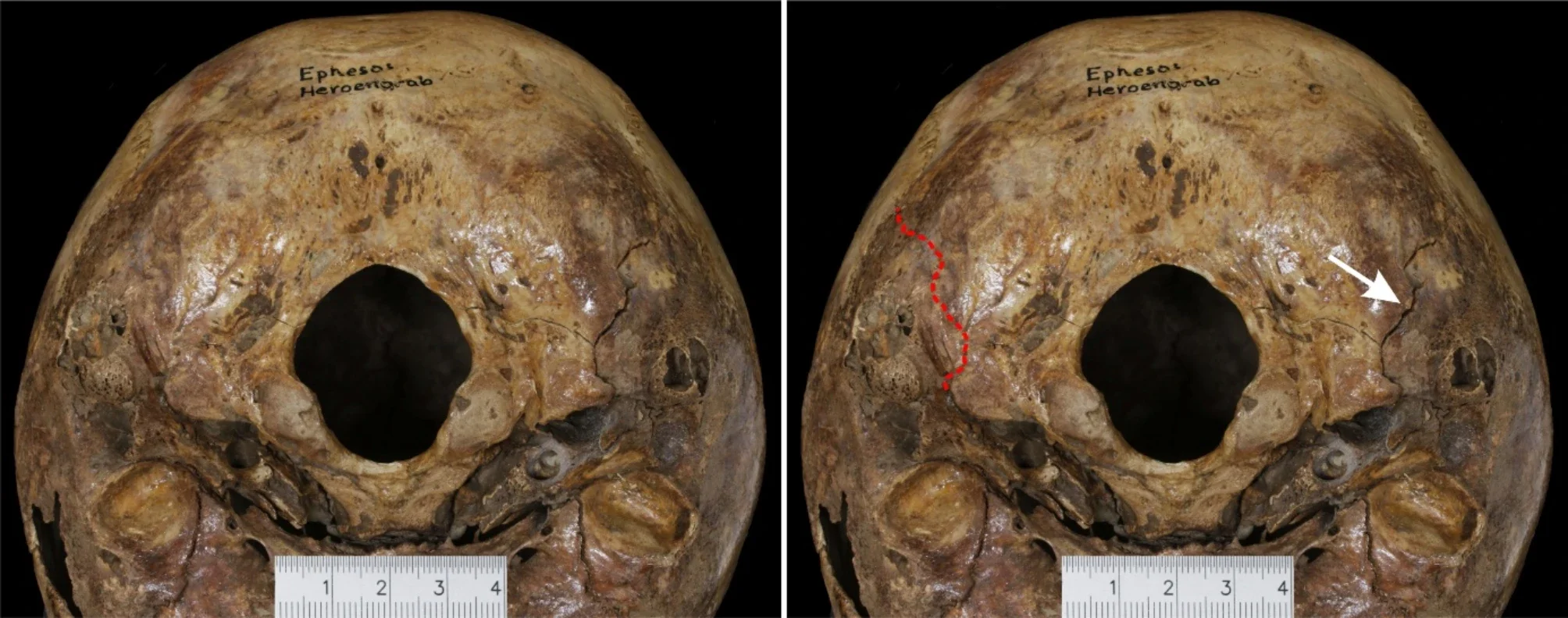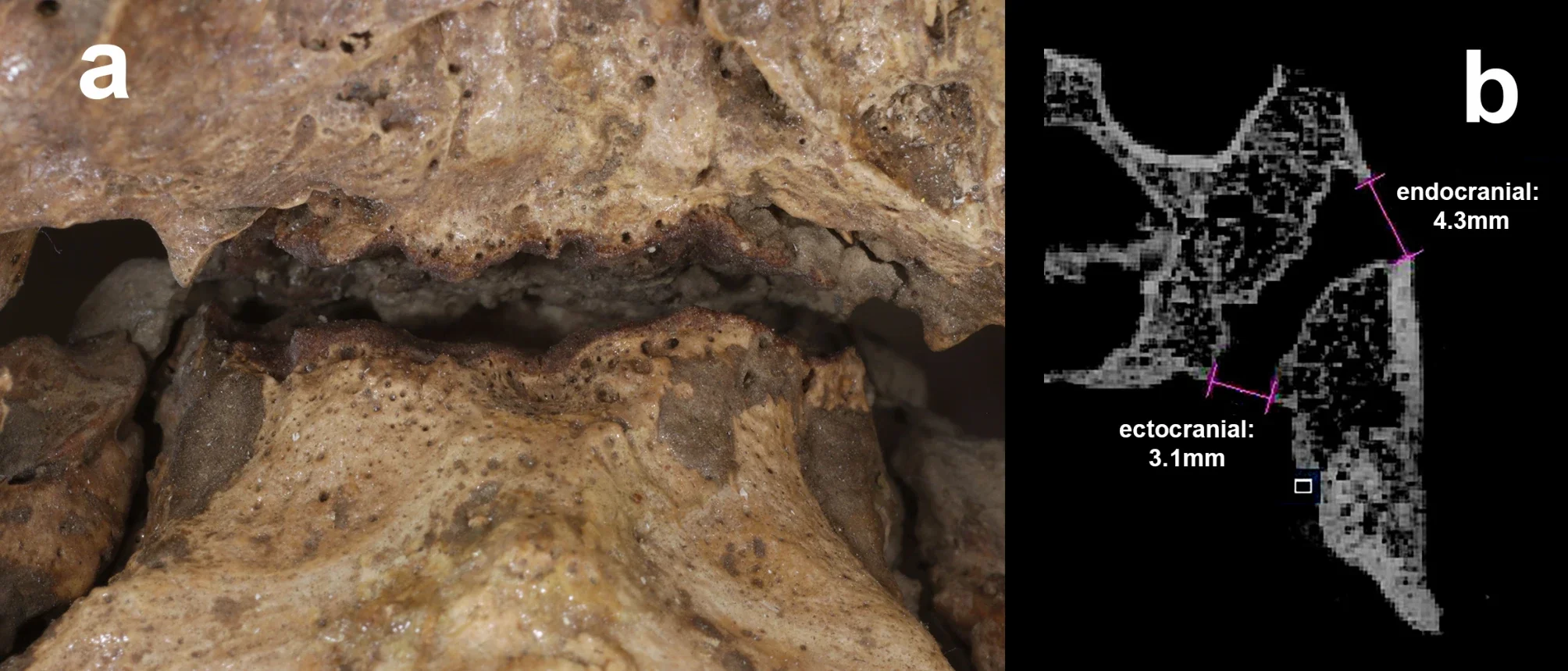A skull discovered nearly a century ago in Ephesos has long sparked speculation about its origin. Thought by some to belong to Arsinoë IV, Cleopatra’s sister, the artifact’s true identity eluded confirmation—until now. New interdisciplinary research, combining advanced genetic analysis and high-resolution imaging, has finally provided answers.
In 1929, archaeologists uncovered a sarcophagus filled with water in the Octagon, an architectural marvel in ancient Ephesos. Inside was a skeleton, though only the skull was removed for study.
Initially believed to belong to a young woman of noble heritage, it was later transported to Vienna, where it became central to rumors linking it to Arsinoë IV. Her tragic story—marked by her struggle for power against Cleopatra and eventual execution in Ephesos in 41 BCE—seemed to align with the grandeur of the burial site.
The architectural similarities between the Octagon and Egypt’s Pharos of Alexandria further fueled speculation. These connections inspired decades of conjecture about the tomb’s occupant and its historical significance. However, a thorough re-evaluation of the skeletal remains has turned this narrative on its head.

Recent research, published in the journal, Scientific Reports, has transformed our understanding of the skull, now identified as belonging to a young boy, not Arsinoë IV. Micro-computed tomography provided intricate digital models of the cranium, revealing developmental abnormalities.
Radiocarbon dating aligned the remains with a time frame between 205 and 36 BCE, consistent with Arsinoë’s era but irrelevant due to the boy’s confirmed gender.
Genetic analysis corroborated the findings. Both the skull and a femur retrieved from the burial site contained Y chromosomes, unequivocally identifying the individual as male. Further examination determined his age at death as 11 to 14 years, with pathological features suggesting significant developmental disturbances.
“The findings not only dismiss the Arsinoë hypothesis but open a new chapter in understanding this enigmatic burial,” explains Gerhard Weber, lead anthropologist on the study.
Related Stories
The boy exhibited striking craniofacial anomalies, including an underdeveloped upper jaw with an unusual downward inclination. This likely impaired his chewing ability, as evidenced by uneven wear on the few remaining teeth. While his first molar appeared untouched, the premolar was heavily worn and cracked, pointing to compensatory chewing habits.
The skull’s asymmetry was another standout feature. One cranial suture—typically closing only in old age—was prematurely fused, contributing to the deformity. High-resolution scans of the inner ear and jaw angles reinforced the evidence of developmental disruptions. These characteristics, coupled with his fragile bone structure, suggest possible conditions such as Treacher Collins syndrome or severe vitamin D deficiency.
The findings extend beyond physical anomalies. The cranium’s brachycranic shape—short and broad—contrasted with earlier interpretations describing it as dolichocranic, or elongated. Its endocranial capacity measured 1,428 cubic centimeters, within the normal range for modern humans. Yet, the pronounced asymmetry and abnormal cranial angles place the skull outside typical human variation.
Further analysis of the foramen magnum—the opening at the skull’s base—revealed an oblique orientation, contributing to overall cranial asymmetry. The mandibular fossae—the jaw’s articulation points—also displayed unusual angulation, diverging notably between the left and right sides. These findings underline the severe developmental disturbances that shaped the boy’s physical form.

While the cranium’s features shed light on the individual’s physical state, questions about his identity and societal role remain. The Octagon’s design and its prominent location indicate a tomb intended for someone of high status. The connection to Egyptian architectural styles might reflect cultural influences or symbolic ties rather than a direct link to Arsinoë IV.
The tomb’s grandeur and the boy’s burial within it raise intriguing possibilities. Could he have been a child of Roman aristocracy or another influential figure whose legacy has faded? The lack of grave goods complicates efforts to contextualize his life and death, leaving much to speculation.
The Octagon itself, a distinctive structure in Ephesos, bears architectural similarities to the famous Pharos of Alexandria, a connection that inspired early theories about its Egyptian influences. Its central location along Curetes Street, one of Ephesos’s main thoroughfares, further emphasizes its significance. Such a prominent burial site suggests that the boy’s family held considerable social or political power.
This discovery underscores the importance of integrating advanced technologies with historical archaeology. Micro-computed tomography, combined with genetic and isotopic analyses, has proven invaluable in reconstructing the life history of ancient individuals.

“Modern techniques allow us to revisit and reinterpret long-standing mysteries,” notes Weber. “This case demonstrates how interdisciplinary approaches can challenge assumptions and reshape narratives.”
Radiocarbon dating offered a precise timeline for the burial, while isotopic analysis suggested the boy’s origins lay in the Italian peninsula or Sardinia. These findings not only refine the historical context of the Octagon but also contribute to broader understandings of migration and cultural exchange in antiquity.
The clarification of the Octagon burial’s identity frees researchers to explore the broader historical and architectural significance of the site. It also reignites the search for Arsinoë IV’s final resting place, a quest that may yet yield new insights into her tumultuous life and tragic end.
The boy’s story—marked by developmental challenges and an untimely death—offers a poignant glimpse into the ancient world. Though he remains unnamed, his skeletal remains have illuminated the capabilities of modern science in unraveling the past. As research continues, the Octagon’s secrets may further enrich our understanding of Ephesos’s history and its connections to ancient civilizations.
The significance of the Octagon extends beyond its architecture and burial. It serves as a testament to the complexities of historical narratives and the enduring mysteries of ancient societies. The boy’s burial within such an elaborate structure raises questions about societal values, familial status, and the commemorative practices of the era.
As archaeologists and researchers delve deeper, they may uncover additional artifacts or evidence to provide context for the Octagon’s construction and its ties to both local and broader cultural influences.
This case exemplifies the potential of scientific inquiry to challenge long-held beliefs, offering new perspectives on history and humanity.
Note: Materials provided above by The Brighter Side of News. Content may be edited for style and length.
Like these kind of feel good stories? Get The Brighter Side of News’ newsletter.
The post Archeologists discover that Cleopatra’s sister’s remains are missing appeared first on The Brighter Side of News.